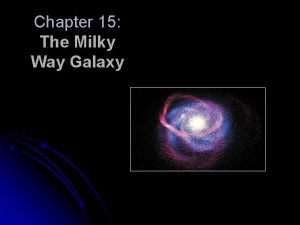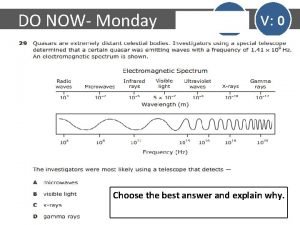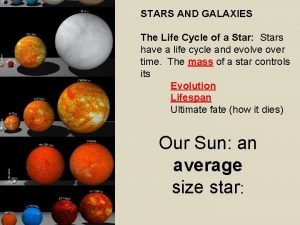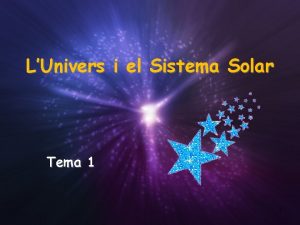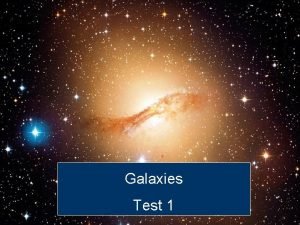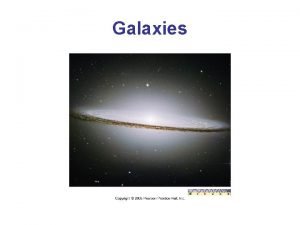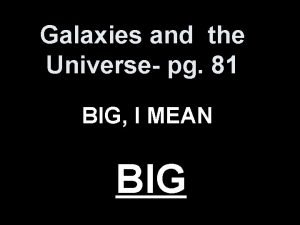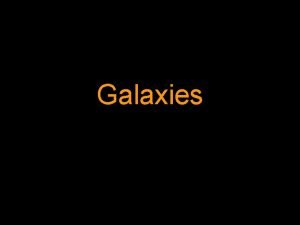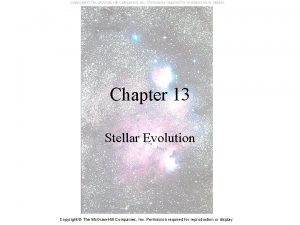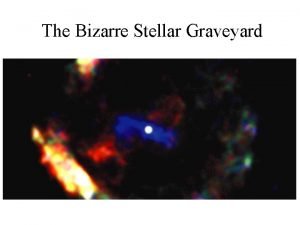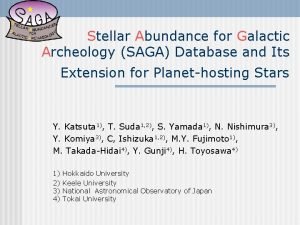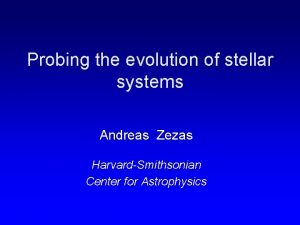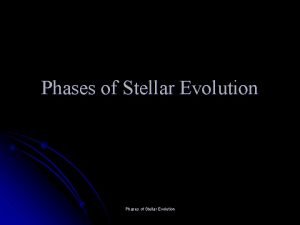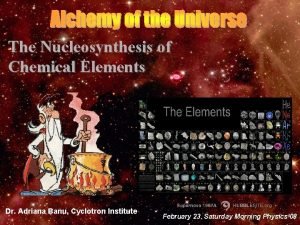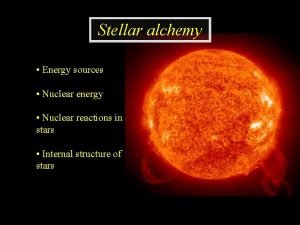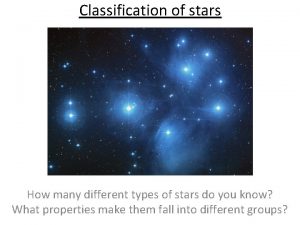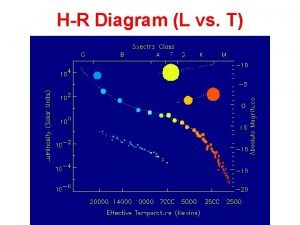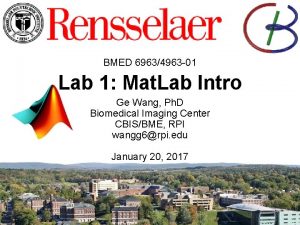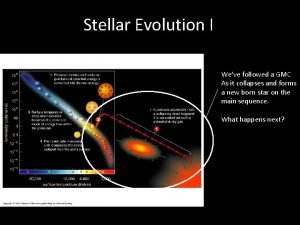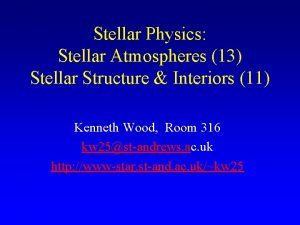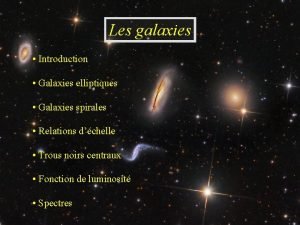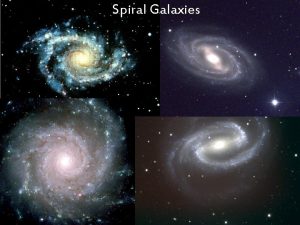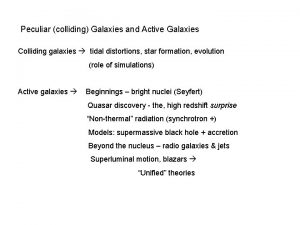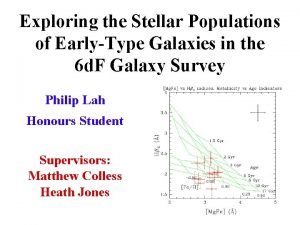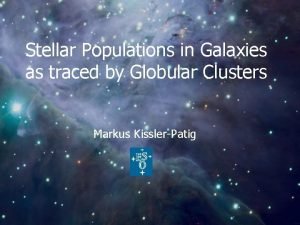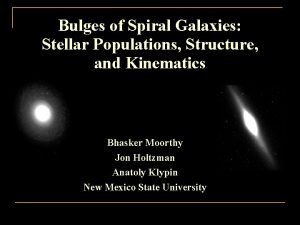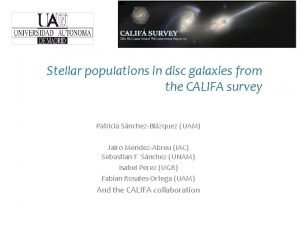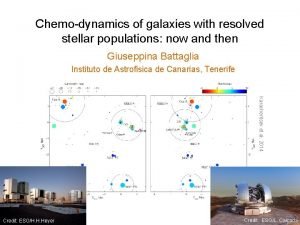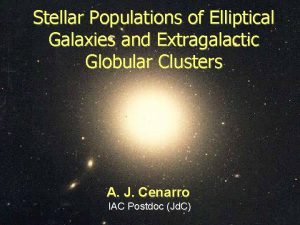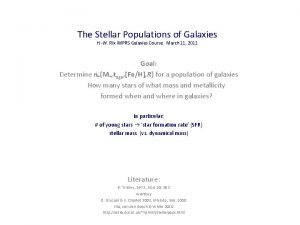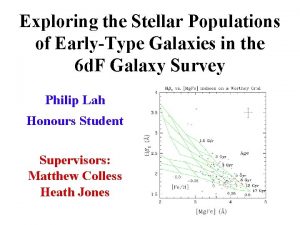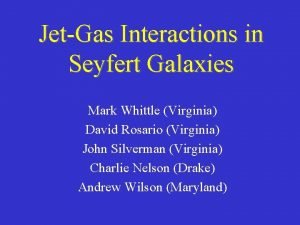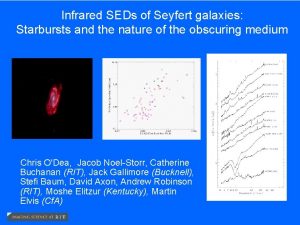Stellar populations in the nuclei of Seyfert galaxies
































- Slides: 32

Stellar populations in the nuclei of Seyfert galaxies Elena Terlevich INAOE, Mexico Collaborators: Roberto Terlevich (INAOE and Io. A) Juan Pablo Torres Papaqui (INAOE)* Alessandro Bressan (Padova) Angeles Diaz (UCM) Daniel Kunth (IAP) Jorge Melnick (ESO) Benoit Joguet (IAP) Roberto Cid Fernandes (Florianopolis) Q. Gu (Nanjing) Moriond, March 2005

Starbursts and AGN In recent years we have seen a dramatic increase on the evidence that Massive Black Holes populate the central regions of most galaxies and also that nuclear star formation may play an important role in Active Galactic Nuclei (AGN). If a SB-AGN connection exists, and if the nuclear SB has different characteristics for different AGN types, this will be of importance both for galaxy (and AGN) formation and evolution models. I will summarize evidence for massive star formation in AGNs and report our efforts to characterise it.

A serious observational difficulty ● It is very difficult to detect the stellar absorptions from a young stellar population in the presence of ionized gas emission.

Balmer absorptions in star clusters are very narrow when very young and broaden substantially with age Gozalez Delgado, Leitherer and Heckman (1999): Ap. J, 125, 489

Spectrum of a very young cluster

Expanded spectrum

Zoomed blue section

It is much easier to detect the absorptions in an oldish (>10 Myr) Starburst. Balmer absorptions are contaminated Ca. II triplet is not contaminated!

The presence of strong Ca. II triplet 8494, 8542, 8662 A absorptions in a large sample of Seyfert type 2 and some type 1 nuclei provided the first direct evidence for a population of red supergiant stars in their nuclear regions. Terlevich, Diaz and Terlevich (1990) MNRAS, 242, 285

More recent work with HST All the UV to near-IR continuum light in at least some Sey 2, all the ones observed with HST so far, is due to a nuclear starburst (SB), which is resolved in UV. In the very luminous Sey 2 Mk 477, seen as a Sey 1 in polarized light, the nuclear SB is at least as luminous as the Sey 1 component. Other Sey 2 also have comparable SB luminosities to those of their ionizing engines. Thus an observer situated along the axis of the torus will detect comparable contributions to the optical continuum coming from the SB and the Sey 1 or broad line region (BLR) component. Heckman, Krolik, Meurer, Calzetti, Kinney, Koratkar, Leitherer, Robert and Wilson (1995): Ap. J 452, 549 Heckman, Gonzalez-Delgado, Leitherer, Meurer, Krolik, Wilson, Koratkar and Kinney (1997): Ap. J 482, 114

More recent results ● ● The improvement in UV sensitivity of optical detectors has lead to detection of higher order Balmer absorptions in the nuclei of many AGNs. These are the lines least contaminated by emission.

Balmer absorption in Type 2 AGNs Near UV spectra of type 2 Seyferts showing the range of strengths encountered in the upper Balmer series and in Ca. II absorption lines. Joguet et al 2001 Cid Fernandes et al 2004

Ground based, near-UV spectroscopy of the nucleus of about 100 Southern Seyfert 2 galaxies showed that: About 50% have high-order Balmer lines in absorption; About 25 % have strong emission lines and only two weak absorption lines: Ca. II K and G band; and About 25 % show many metal absorption lines, and a reddish continuum. Thus the study of a representative sample of Seyfert 2 nuclei indicates that about half show the direct spectroscopic signature at optical/near-UV wavelengths of hot massive young stars. Joguet, Kunth, Melnick, Terlevich and Terlevich (2001): , A&A 380, 19 Cid Fernandes, Heckman, Schmitt and Storchi-Bergmann(2001): Ap. J 558, 81

Nuclear Starbursts in powerful Radio galaxies The analysis of the nearest powerful FR II radiogalaxies has discovered spatially extended Balmer absorption, with strengths characteristic of B-A giant or supergiant stars at the center of at least two of them Hydra-A and 3 C 285. The ages derived for the young population are between 7 and 40 Myr. Four more nearby FRIIs (although with poorer data) also show Balmer line strengths which are systematically larger than those found in elliptical galaxies. The Ca II triplet in absorption was detected in all six radio galaxies. Melnick, Gopal-Krishna and Terlevich (1997): A&A 318, 337 Aretxaga, Terlevich, Cotter and Diaz (2001): MNRAS 325, 636 Tadhunter, Robinson, Gonzalez-Delgado, Wills and Morganti (2004): MNRAS


Nuclear Starbursts in Type 1 AGNs Recently we have started to detect high order Balmer lines in type 1 Seyferts. This finding might suggest a very compact and luminous SB as the nuclear light in these type 1 Seyferts is dominated by a basically unresolved nuclear component. The fraction of Seyfert 1 nuclei with Balmer absorption seems lower than in type 2 Seyferts, but contamination by the light from the BLR makes the detection of stellar absorptions in type 1 Seyferts much more difficult than in type 2 ones.

Nuclear Starbursts in Type 1 AGNs Type 1 Seyferts. (NTT+2. 1 m OAGH). Torres-Papaqui et al 2005


Massive stars in Seyferts

● The main conclusion at this stage is that there is compelling evidence that at least in the near Universe a large fraction of AGN, both radio-quiet and radio-loud have a nuclear young cluster or Starburst with luminosities comparable or even larger than that of the Broad Line Region.

What are the properties of these nuclear starforming regions, and, can we estimate the age of these young stellar clusters? Stellar absorptions in Seyfert galaxies suffer dilution by the nuclear non-stellar component. This dilution makes the use of traditional methods based on absorption line strength analysis extremely difficult.

We have developed an alternative method that uses the profile of those absorption lines whose main broadening mechanism is related to the surface gravity of the stars. The hydrogen Balmer series and the Ca. II H and K lines are excellent examples of this effect, both sets of lines becoming increasingly broad as the stellar population ages. In the near UV spectra of Seyferts the main characteristics of recent star formation are strong emission lines plus Balmer absorptions while strong Ca II absorption is typical of the older bulge population.

High resolution (0. 2 A/px) Padova/INAOE models Terlevich, Bressan, Terlevich and Torres-Papaqui (2005) in preparation.

Evolution of the FWHM and EW of Balmer H 10 Broadened profiles 400 Myrs 20 Myr

Evolution of the FWHM and EW of Ca. II K Broadened profiles 15 Gyr 100 Myr

Preliminary results Age estimators applied to Seyfert’s nuclear stellar components. Age of Starburst component Age of Bulge component

The nuclear Starbursts in AGN are very young The bulge component is also relatively young Caveat: We have included here only those AGN with detected absorption lines. About 25% of type 2 AGN are dominated by strong emission lines. There are indications that in this subset an even younger Starburst is present but the evidence is not so compelling due to the emission line contamination of the stellar absortions as in any young Starburst.

Simple synthesis of stellar populations = S ’s (+ gas + dust +. . . ) ≈ S SSP’s = x 1 +. . . + x 2 + x 3

The SF-History of Sey 2 nuclei Cid Fernandes, Gu, Melnick, Terlevich 2, Kunth, Rodrigues Lacerda, Joguet 2004 • 79 galaxies 65 Sey 2 s at ESO 1. 5 • ~ 200 pc • Base = BC 03 + FC (featureless continuum). . Emission lines masked-out Strong FC in this Sey 1

Results for 65 Sey 2: for central (median) 174 pc (65 Sey 2); 121 pc (14 -rest) Heterogeneous star formation histories. ● 10 SSP BC 03 ages, Z=1 and 2. 5 solar, plus a power law FC. Some, dominated by old stars (t>2. 5 Ga), to 80% of the optical light; Some show strong component of intermediate age stars (100 Ma<t<1. 4 Ga); Young clusters are ubiquitous (t<25 Ma), in some cases to more than 50% of the light at 4020 A and in several to 20%. Strong FC component also present. This could be a genuine monster or a dusty young burst. At least 3 of the 4 components present with significant strength (more than 10%) in any one galaxy. A simple Ell galaxy + a power law (used many times before) does not apply to the bulk of Sey 2 s.

Conclusions (1) There is substantial direct evidence of massive young stellar clusters present in the central regions of AGN, both low luminosity radio quiet and radio loud ones. ~50% of nearby Seyfert 2, ~30% of observed FRII and ~20% of Seyfert 1 show the high Balmer series in absorption. The analysis of the profile of the Balmer and Ca. II absorption lines (insensitive to both dilution and extinction) provides a new way to estimate the ages of stellar populations, and hence the star formation histories. A sum of state-of-the-art evolutionary synthesis models + a FC can reproduce the stellar population in the central 50 -500 pc of a large, well defined, homogeneous sample of Seyfert 2 galaxies.

Young starbursts, intermediate age and old populations appear in significant and mixed proportions. WR features were discovered in the pure emission (absorption subtracted) spectra of 5/65 galaxies (dating much more precise) for young component. 17 known to have BLR (direct or polarized) show also strong FC in our fitting. Dusty young starbursts are found by strong FC but no BLR. 1/3 -1/2 of nearby Sey 2 have experienced significant SF in the recent past. As a class they live in a much younger stellar environment than LINER’s and normal galaxies. No correlation between host morphology (as per HST optical -near. IR and ground base) and nuclear stellar population. Central stellar velocity dispersions can also be deduced.
 Christy seyfert
Christy seyfert Elliptical, spiral and irregular
Elliptical, spiral and irregular The pity relation for an adiabatic expansion is
The pity relation for an adiabatic expansion is Galaxies lesson plan
Galaxies lesson plan Brainpop galaxies quiz answers
Brainpop galaxies quiz answers Life cycle of a galaxy
Life cycle of a galaxy Tipus de galaxies
Tipus de galaxies Critical density
Critical density 4 types of galaxies
4 types of galaxies Facts about elliptical galaxies
Facts about elliptical galaxies Evolution of galaxies
Evolution of galaxies Type of galaxy
Type of galaxy Chapter 30 galaxies and the universe
Chapter 30 galaxies and the universe How are active galaxies classified?
How are active galaxies classified? E irregulars
E irregulars Universepg
Universepg Types of galaxies
Types of galaxies Waves are produced by stars and galaxies.
Waves are produced by stars and galaxies. Stellar evolution
Stellar evolution Masses in the stellar graveyard
Masses in the stellar graveyard Stellar wifi
Stellar wifi Stellar saga
Stellar saga Stellar
Stellar Stellar evolution diagram
Stellar evolution diagram Adriana banu
Adriana banu Life cycle of a star poster
Life cycle of a star poster Atmospheric heaven
Atmospheric heaven Stellar alchemy
Stellar alchemy What is stellar parallax?
What is stellar parallax? Stellar formation
Stellar formation Stellar motion matlab
Stellar motion matlab Stellar evolution
Stellar evolution Iptv hosting
Iptv hosting



